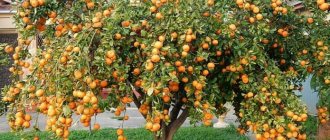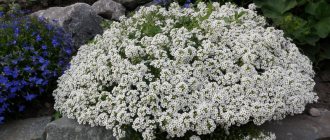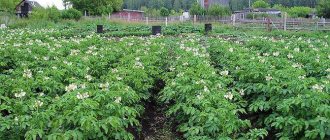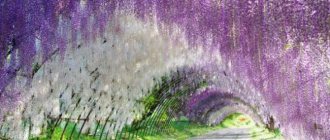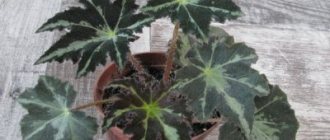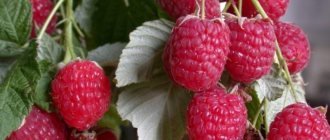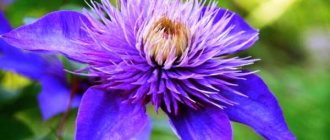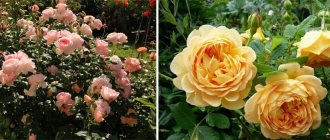Not many people know the houseplant called Crassula, but everyone probably knows what the Money Tree or Crassula looks like. And although its historical homeland is Africa, this flower takes pride of place in the homes of many gardeners. So, this is the same plant, loved by everyone for the unusual beauty of its crown, unpretentious character and its ability to cleanse a room of negative energy and attract wealth and prosperity into the house. In this article you will find useful tips on caring for the Money Tree (Crassula) at home, including during flowering or the dormant period.
Signs
It is widely believed that the money tree contributes to the financial well-being of the owner.
Let us add that only a healthy and well-groomed Money Tree has this property. There is a belief that a diseased plant has exactly the opposite effect on its owner. He may experience failure in financial matters and loss of money. To prevent this from happening to you, try to ensure that the Fat woman living in your apartment is always well-groomed, beautiful and healthy.
However, even with good care, the Money Tree will begin to wither and may even die if it is in a negative atmosphere of scandals between family members for a long time, if its owner or mistress is constantly under stress or seriously ill. Remember this and, if you want a Crassula to live in your home for many years, try to avoid conflict situations and do not get sick.
Contraindications
Otherwise, the medicinal properties of a living tree have practically no contraindications: only people with individual intolerance . In addition, the use of a living tree in treatment is prohibited for pregnant women and nursing mothers, as well as young children, whose bodies may not be prepared.
Related article: Spring pruning of fruit trees
It should be noted that any treatment must be agreed with a doctor. The fact is that living wood contains arsenic. The substance was previously often used in medicine, but now its use raises serious concerns among many doctors, especially when used in excess and self-prescribed. Their concerns are related to the fact that the arsenic compound contained in the plant can accumulate in the body and cause poisoning.
However, it is worth noting that the doses of arsenic in the plant are minimal and will not cause harm if consumed in moderation. Before use, it is recommended to consult a doctor in advance, especially if the diseases concern internal organs. Exceeding the permissible dose is also prohibited.
Beneficial features
Everyone knows that the Money Tree has positive energy. In addition, it also has healing qualities and is a filter plant. Its leaves release phytoncides into the air, which have pronounced antiviral, antifungal and antibacterial properties, thereby disinfecting the air in the room.
Crassula leaves contain arsenic; eating them is strictly prohibited.
But externally, Money Tree sap is used to treat many diseases:
- For sore throat and gum inflammation - in the form of rinses. To rinse, take juice from several leaves and dilute it 5 times with warm water. Rinse your mouth and throat with this solution up to 5 times a day.
- For insect bites, herpes, abscesses, bruises, cuts - in the form of lotions. For lotions, take a few leaves and crush them into a paste in a mortar. Apply a sterile bandage soaked in this paste to the sore spot. If necessary, you can make a bandage and keep it on the wound for up to 4 hours. Particularly effective for muscle sprains and bruises. Herpes is treated with Crassula juice - every 30 minutes. lubricate your lips with it.
- For joint diseases, arthritis, arthrosis - in the form of rubbing the juice of the plant before bed.
- For calluses – peel the film from the leaf and attach it to the callus with a band-aid overnight.
We remind you that you can only use Money Tree juice externally. The lack of regular flowering in an indoor flower makes it practically hypoallergenic. Very rarely, allergies may appear in the form of redness, itching, tearing or rash. In this case, this medicine should be abandoned. Pregnant women, children and nursing mothers should not take risks.
Benefits of Crassula
The money tree contains a large number of useful trace elements and volatile oils, which allow the use of medicinal properties for a number of diseases. Most often, the medicinal properties of Crassula are used as an antibacterial and antiviral drug . It is used:
- When healing wounds, insect bites and their disinfection, the juice of the plant also prevents the appearance of swelling and eliminates itching;
- To combat herpes, corns and calluses;
- To relieve attacks of varicose veins, arthritis, arthrosis, hemorrhoids and gout;
- For throat diseases and severe cough;
- Can be used for stomach and duodenal ulcers.
Caring for the Money Tree at home
Check out our article Crassula (Money tree or Crassula) - types, photos and names in order to choose a flower to your liking. Here we will tell you about how to care for Crassula so that it pleases you for many years.
Location and lighting
Intense lighting is the key to the active growth, health and beauty of your pet. The place for the pot must be chosen on a spacious windowsill facing south, southeast or southwest directions or close to them. Almost all types of tree-like Crassula, namely Crassula, respond well to sunlight. The color of their leaves directly depends on the intensity of lighting.
Only in varieties with purely green leaf color from the midday sun can the surface of the leaves become dark brown, and its edges acquire a reddish edging. To prevent this from happening, shade such a flower from direct sunlight in the middle of the day with a curtain or blinds. Other types of Money Tree are not afraid of direct sunlight.
With a lack of lighting, variegated and flowering varieties may lose the bright color of their leaves and not bloom. To ensure uniform formation of the flower crown, it is necessary to periodically turn it to the light source in different directions. In the summer, it is advisable to take all Crassulas out into the open air. Choose a place that is well lit but protected from the wind - there they will grow well, and some will bloom.
If your apartment has only north-facing windows, you cannot do without the help of a phytolamp or a fluorescent lamp. Without them, in a short time the plant will lose its decorative effect - the shoots will begin to stretch towards the light, the leaves will thin out, fade and fall off.
Content temperature
The money tree feels good at normal room temperature within 22 - 28 degrees. In summer, it can be taken out to the balcony, veranda, or garden. If you don’t have this opportunity, move the pot from the windowsill to the floor - it’s a little cooler there. Changing the temperature during the day only benefits the flower.
How to care for the Money Tree during dormancy
In winter, Crassula prefers to rest. From the end of November to February, it needs to be provided with a lower temperature: 14 - 16 degrees. Remove the pot away from heating appliances, place it near the balcony door, ventilate the room more often (not forgetting that drafts can destroy the plant). Water once a month, do not feed. If you have a heated loggia, Crassula can winter on it at a temperature of 8 - 10 degrees. At high temperatures during winter dormancy, the plant may lose its leaves and lose its decorative appearance. Experts say that Crassula can withstand temperatures dropping to 0 degrees. But we do not advise you to do this. But try to provide three months of cool conditions.
We remind you that the plant does not tolerate drafts.
Watering
It is important to know how to water a money tree at home. Crassula reacts strongly to the presence of excess moisture in the soil. We can say that the flower needs little moisture. Never overwater succulents. Their root system is prone to rotting, the leaves will immediately begin to fall, and the lush crown will turn into a bald stem. Therefore, before you start watering, make sure that the pot has drainage holes. If there are no holes in the bottom of your pot, you will have to make them - drill them with a drill or burn them with a hot awl. Now you can water.
This may be interesting: Kalanchoe - home care
In summer, the Money Tree is watered generously once every 2 to 3 weeks. Young specimens are watered more often, especially in hot weather, every week. During this time, the substrate should dry out at least 2 - 3 cm deep into the pot.
If you have an adult plant, you can easily go on vacation without worrying about watering it. The thick, succulent leaves of the Money Tree retain moisture, and the plant can wait a month for your arrival without losing a single leaf.
In the fall, water Crassula every 3 to 4 weeks. Remember that the top layer of the substrate dries out very quickly, especially on a sunny windowsill through glass, but this is a deceptive point. Check a little deeper - most likely the soil around the roots is still damp. Make the next watering when the substrate dries 4 cm deep into the pot.
If the soil does not dry out for a long time between waterings, it means that it was chosen incorrectly or the pot is too large and the problem lies there. Excess moisture after watering must be drained from the pan.
In winter, if the Crassula is in a cool room on vacation (from November to February), watering is reduced to a minimum. Just make sure that the soil in the pot does not dry out completely. The leaves serve as a signal for watering - they become soft.
Water for irrigation should be used, settled, filtered or boiled, at room temperature or a couple of degrees higher.
Humidity
Indoor humidity does not play a big role in the life of the Money Tree. This plant is a succulent. Its stems and leaves accumulate moisture and consume it during unfavorable dry periods, for example during the heating season. Provided the room is regularly ventilated, it feels great in a city apartment. If for some reason the Crassula finds itself in a humid microclimate, then watering is reduced to a minimum. And this flower does not need spraying, because this can lead to a deterioration in the appearance of the leaves and even to their rotting.
At the same time, to maintain the cleanliness and elasticity of the leaves, they should be wiped with a damp sponge or cloth. Clean leaves are better saturated with oxygen. As long as the dimensions of the flower allow, you can periodically wash the leaves with a warm shower in the bathroom. Just make sure that water does not get on the substrate; it is better to cover the pot with film.
The soil
What kind of soil is needed for a Money Tree? The soil should not be so much nutritious as it should be loose, moist and breathable. A special soil for succulent plants, which can be purchased at flower shops, is suitable. It is also possible to cook it yourself. To do this, mix 1 part of leaf soil, 3 parts of turf soil, 1 part of humus, 1 part of coarse river sand, 1 part of fine gravel or agroperlite. You can add a little ash. Feng Shui lovers can put two or three coins of different denominations to attract wealth. Add pieces of charcoal or activated carbon to the bottom of the pot along with the drainage to prevent fungal infections.
Pot
The root system of the flower is fibrous, rather weak, and superficial. Therefore, the pot for the Money Tree must be selected according to the width of the roots. In addition, it should be shallow and heavy, preferably clay, so that the growing tree does not topple it. In such a pot, the roots will develop well, delivering moisture and nutrients to the stems and leaves.
Young, fast-growing Crassulas will need to change the pot after a year - to a more spacious pot. Adult specimens require transplantation less often - once every 2-3 years. In adulthood, the Money Tree has a lush crown and a tall, strong trunk. The risk of the pot tipping over increases. During the next plant transplant, we recommend installing a support in the pot and tying the flower to it.
Pay special attention to the drainage layer. Crassula is a very sensitive plant to excess moisture, so a good drainage layer in the pot is essential. Any non-rotting material can be used as drainage - expanded clay, stone, pebbles, cork. Before use, disinfect them.
Top dressing
The money tree needs feeding only during the active growth of stems and leaves - from late spring to mid-August. Three baits are enough during this time. Preference should be given to fertilizers for cacti or succulents. To avoid damage to the root system, fertilizing should be applied in liquid form some time after the main watering.
If the flower was transplanted into a new substrate in the spring, you should not feed it this season. In winter, the plant is also not fed.
Transfer
The best time to transplant Crassulas is considered to be autumn or the end of March - April. Young trees are replanted annually, adults - after two to three years.
So how do you replant a Money Tree? If the time has come, remove the flower from the old pot. Inspect its root system. Cut off broken, rotten or too long roots with a sterile instrument. Sprinkle the cut areas with crushed activated carbon. Leave the tree in the air for several hours - let the wounds dry out and heal. Only then start planting in a new pot.
If you do not find any visible damage to the root system, do not disturb the earthen ball, but simply transfer the plant along with the soil into a new pot, which already has a drainage layer and some fresh substrate. Fill all the roots with fresh soil so that there are no voids left in the pot. Do not bury the root collar. Lightly compact the substrate and water.
When buying a plant in a store, do not rush to immediately transplant it into a new pot when you arrive home. Let him live with you for a couple of weeks in a shipping container, in a warm, well-lit place. Let him adapt to new conditions. At this time, eliminate any negative impact on the tree, surround it with attention and love. Remember that it is very important for a young Money Tree to feel the positive energy of the room. Only after this can the transplantation begin.
If there is a need to replant an adult large plant that has a thick trunk and a heavy crown, prepare for it a wider ceramic pot, at the bottom of which place two or three stones to make the pot heavier, make it more stable and prevent the flower from falling. Use the transplant to install a support in the pot and tie the stem to it. After replanting, while the root system is fixed in the new pot, cover the trunk of the tree on top of the substrate with large stones to prevent the Crassula from falling on its side. Place the flower in partial shade for a week and do not disturb it, let the roots become fixed in the substrate. Then the stones need to be removed.
This may be interesting: Decembrist (Schlumbergera, Rozhdestvennik, Zygocactus) - care, reproduction and disease
How to form the crown of Crassula
If the flower has already reached the size you need and you do not want the Money Tree to continue growing, stop replanting it in a larger pot. Just change the top layer of substrate in the old pot every year.
The crown of the Crassula itself forms in the form of a tree. But you need to know how to prune a Money Tree at home, because some side branches will grow so large that they will break under their own weight. The end result will be a tree of a completely unsightly shape. If you start pruning a young plant in a timely manner, you can form a neat and beautiful mini-tree of its original appearance.
Start forming a Money Tree in infancy, when the stem and shoots are gray-green in color, and cuts do not leave marks on them. When pruning an adult tree, stumps remain in the pinched areas, which spoil the decorative appearance of the flower.
The essence of crown formation comes down to first removing the lateral shoots until the tree grows to the desired height: the bare stem should be about 15 cm, and the entire plant 25 - 30 cm in height. Now you need to pinch off or cut off the crown with the two upper leaves. After some time, four leaves will appear in their place. Continue doing so. As your tree grows, pinch out the top bud of the shoot in the places where you want new shoots.
Try to have no more than four pairs of leaves on each branch of the Money Tree. If you missed the moment and 6–7 pairs of leaves have formed on the branch, pruning above the growth point of the fourth pair of leaves will help. Sprinkle the cut with crushed charcoal or cinnamon powder. To avoid branches bending to one side, turn the flower to the light with different sides more often.
The money tree belongs to the tree form of Crassula, grows in the form of a tree and gradually sheds its leaves at the bottom of the woody trunk.
This is what your tree should look like: the stem is thick, gray-green. Over time, it becomes lignified from below. On top it is decorated with a neat crown of thick leaves of dark green or silver color, with a glossy surface, with a reddish edging or spots of the same tone. The height of the flower can be whatever you want - from 50 cm to one and a half meters.
The Money Tree can also be given the appearance of a bonsai. This will take some time, perhaps more than one year. First, you should grow a strong tree whose trunk reaches the thickness you need. Then you will cut it off radically and wait patiently for new branches to grow. You will cut off almost all the leaves of these branches - leaving only those at the very ends. So, gradually, you will form the desired crown of your pet, and the Money Tree will be the main decoration of your interior.
Bloom
Crassula (Money tree) rarely blooms at home and only in adulthood (about 10 years). Crassula, with a high degree of probability, can only be encouraged to bloom by ideal maintenance conditions: intense lighting all year round, a long cold winter and regular replanting of the plant into new soil. If a miracle happens, then in the spring you will be able to see the Money Tree bloom. Flowering will continue for two to three months.
This is how the money tree blooms
Numerous flowers, collected in loose inflorescences in the form of umbrellas, will appear at the ends of young mature shoots (therefore, pinching and pruning in order to form a crown should be done in early spring, so that after pruning these shoots appear, so that they grow over the summer and ripen until autumn , when the laying of flower buds begins for flowering next year). The Money Tree's flowers are very small, star-shaped, white with a pinkish or greenish tint.
The flowering tree will emit a strong sweet aroma throughout the flowering period. Faded inflorescences should be removed so that the plant does not waste energy on producing and growing seeds. Try to properly care for your beautiful Crassula, and we hope that it will delight you with beautiful blooms.
Living tree - medicinal properties, recipes
A living tree is a fairly common plant, often grown in a city apartment. There are more than two hundred of its varieties, and all of them are attractive, decorative and have many healing properties. The living tree is more commonly called Kalanchoe and is characterized by many fleshy, succulent leaves and thick stems. The leaves of this plant seem to be made of wax; they retain moisture well. Let's talk about its therapeutic properties, which have long been used in traditional medicine.
It was not for nothing that our ancestors called a living tree indoor ginseng, as well as a pharmacy from the windowsill. After all, this plant has a wide range of uses.
Kalanchoe is a wonderful anti-inflammatory and bactericidal agent. It perfectly heals damage to the integrity of the epidermis and stops bleeding. This plant is used in the treatment of all kinds of skin lesions - rashes, furunculosis and eczema. It is used to speed up the healing of bedsores, ulcerative lesions, and various cracks. The living tree has a remarkable anti-burn effect and cures cervical erosion. Consuming the juice helps stop the development of epidermal infections and stop bleeding.
Medicines based on Kalanchoe are prepared according to the same principle as medicines from aloe. Cut the leaves from the plant, wrap them in plastic and place them in the vegetable section of the refrigerator for five to seven days.
In order to extract juice from raw materials, remove it from the refrigerator, rinse thoroughly and pat dry with a regular napkin. Then thoroughly grind the raw materials, for example, by cutting with a sharp knife or using a blender. Squeeze the juice through a bandage or gauze and pour it into a glass container. Place the jar in the refrigerator, and after a couple of days, filter the product and sterilize. The finished rolled product can be stored for a year.
To make an ointment, you need to mix lanolin and living tree sap in a ratio of 5:3. Then mix another fifty grams of Vaseline into the mixture and bring the product to a homogeneous consistency.
An alcohol tincture on a living tree is made as follows: combine crushed Kalanchoe leaves in the amount of five tablespoons with two hundred and fifty milliliters of vodka. Leave to infuse in a cupboard for about two weeks. The medicine is best prepared away from light and heat.
Article on the topic: Hawthorn Maksimovich description and features
Ointment from a living tree is usually applied to manifestations of eczema, rashes, boils, abscesses and trophic ulcers.
The tincture is used to treat inflammatory processes in the middle ear. To achieve a therapeutic effect, it is recommended to instill a couple of drops of this product into the ear, then placing a compress on top.
If you have a runny nose, flu infection or sinusitis, lubricate your nasal mucosa with Kalanchoe juice. This procedure can be repeated four times a day.
If you find stomatitis or some other ulcers in your mouth, or you have developed a sore throat, take a couple of Kalanchoe leaves and brew them with two hundred and fifty milliliters of boiling water. Let the product cool slightly and use it for rinsing four to five times a day.
Prevention of influenza and various colds and viral ailments can be carried out by applying fresh juice from Kalanchoe leaves to the mucous membranes of the nose immediately before each trip outside.
If you suffer from toothache, chew a leaf from a living tree every half hour for at least five minutes.
For mastitis, you should thoroughly soak a couple of gauze napkins with Kalanchoe juice. Apply the resulting compress to your chest and place foil or special paper on top. Put on any old bra and go to bed.
Treatment of burn injuries, trophic ulcers, and boils is carried out according to the same scheme. Napkins soaked in juice should be applied to the affected areas. If the lesions are quite extensive, dripping juice can be applied directly to them. It is not necessary to use a compress.
Hard-to-heal wounds can be cured with a special mixture of Kalanchoe ointment and St. John's wort oil in equal proportions. Apply this medicine to sore areas four times a day.
The sap of a living tree provides recovery from periodontal disease. To do this, pour it into a small spray bottle and use it for periodic irrigation of the oral cavity.
To combat loss of strength and anemia, as well as in the treatment of infectious diseases and increase the body's defenses, you should eat a tablespoon of Kalanchoe babies. Repeat every day. Babies can also be added to vegetable salads.
Alcohol tincture can be rubbed into the legs for varicose veins. In this case, you need to move carefully from bottom to top, making circular movements. The duration of such treatment is three months.
There is a wonderful way to treat cervical erosion. Simply soak a cotton swab with Kalanchoe ointment and insert it into the vagina. Repeat the procedure after four hours. The duration of such treatment is one week.
Remember that all proposed recipes can be used in parallel with official treatment. You should not carry out therapy with folk remedies without first coordinating it with your doctor.
Money Tree Reproduction
Propagation by cuttings and leaves
Crassula is most often propagated using cuttings. Even an accidentally broken twig can be suitable for you as planting material. We recommend that if propagation is necessary, do not break the branches, but carefully cut the stem or leaf cuttings with a clean knife. Powder the cut area with crushed activated carbon to prevent infection. Give the wound time to air dry. Crassula has poisonous leaves, so place the cutting in a place where animals and children cannot reach it.
Then, place the cutting for rooting in a slightly damp substrate to a depth of 5 cm. If you are rooting a leaf, the depth of its immersion in the substrate should be 1 cm. It is better to carry out this operation in the spring, in March - April. It would be good if you set up a mini greenhouse for the seedlings. Use a mixture of peat and sand as a substrate. The greenhouse needs to be ventilated and the soil moistened with a fine spray bottle if necessary. Maintain the rooting temperature within 18 – 22 degrees. Usually, rooting of cuttings occurs quickly and without problems. How to plant a Money Tree shoot? As soon as you see that your young tree has begun to grow and develop and has reached 10 cm, transplant it into a pot of suitable size, place it in a well-lit place in partial shade and care for it as you would an adult plant.
Very often, cuttings are rooted in a glass of warm, settled water. To prevent the stem from rotting, add an activated carbon tablet to the water. And to make roots appear faster, a solution of a root formation stimulator, for example Kornevin or Zircon, is dripped in there. After stable roots appear, the cutting can be transplanted into its own pot.
Propagation using seeds
Another way to propagate the Money Tree is through seeds. This method is less common and less effective. If you decide to get your copy of Crassula this way, we will help you. Prepare a substrate for succulens, a container, and seeds. Place a layer of moist soil at the bottom of the container, place the Crasula seeds on it, and cover the lid. If necessary, ventilate and moisten the substrate using a fine spray bottle with warm water. The best time to sow seeds is February. In two weeks, wait for the first shoots to appear. After sprouts appear en masse, move the greenhouse to a bright, warm place and provide additional lighting so that they do not stretch out. Start opening the lid of the container, first for a while, and then remove it completely. As soon as the sprouts become stronger, they can be transplanted into separate small pots. In the first year, the plant is not given a period of rest - let it grow and gain strength.
This may be interesting: Aloe is the green doctor
Where did the tree come from to attract money?
The history of the money tree began more than one and a half thousand years ago. The plant itself comes from Africa, but very quickly became famous in the East. It was the merchants of the Middle East who called Crassula the money tree, because its leaves are so similar to coins.
In Europe, crassula began to be used to attract money only in the 17th century. This is due to the inclusion of the plant in gardening reference books. The further spread of Crassula among the masses was facilitated by its magical property of attracting wealth.
Diseases
Crassula rarely gets sick. She has a pretty strong immune system. However, if you seriously neglect the rules of keeping her indoors, she will get sick. Let's consider some such cases.
- If brown spots appear on the leaves of the plant, or if the leaves begin to rot, these are signs of a fungal disease. The reason is excessive humidity of the air and substrate. For the same reason, the Money Tree may experience leaf fall and become bald in a short time. Treat the affected plant with a fungicide containing copper. Adjust the frequency of watering and the quality of water used.
- Why do the Money Tree leaves fall? Sudden shedding of leaves in the summer indicates that you are not watering the plant enough or are watering it with too cold water. If Crassula sheds its leaves every two to three years for no apparent reason, this is the norm.
- If the leaves of the flower are covered with black spots, pay attention to the location of the pot. Perhaps it is standing in the sun and the plant has received sunburn. Move it to another place or shade it. If the Crassula spent the rest period in a dark place, then in the spring it must be accustomed to sunlight again, gradually.
- If the Money Tree begins to dry out and wither, this is a sign of suffocation. The plant is hot. Take it out into the fresh air or ventilate the room, wipe the leaves with a damp cloth, and spray the surrounding air with cool water.
- Why doesn't the money tree grow? It may need to be transplanted into a larger pot. Maybe you haven't fed the plant for a long time. Perhaps insect pests have infested the roots, or the roots have simply rotted from frequent and abundant watering. Either way, replant the Money Tree in a new pot and new substrate. If you find pests, pre-treat the roots with some insecticide: actara, fitoverm, actellik. If there are no living roots, the plant cannot be saved. Try rooting its shoots or leaves.
- If brown spots form on the leaves, these are most likely dry, healed wounds from insect pests. Cosmetic defect, but nothing dangerous.
- Excess moisture may cause the plant trunk to darken. Stop watering for a while. After a couple of weeks, the substrate and the roots in it will dry out well, and the Crassula can recover. If the flower still disappears, take it out of the pot and inspect the roots. If they are all black and soft, the flower cannot be saved. Cut off the top and try to root it. If only part of the roots is affected, remove them and all rotten parts of the plant. Treat with fungicide or crushed coal. Plant in a new container with new substrate. And watch the watering schedule.
- The roots may partially die off if there is no watering for a long time during the hot season (for example, the owners were on vacation). When watering is resumed, the plant will almost certainly grow new roots, if root rot has not occurred.
- If the leaves of the Money Tree become soft and lose turgor, then this looks like insufficient watering or lack of nutrients in the soil. Rather, water the plant with warm, settled water. After watering, if necessary, fertilize with fertilizer for cacti or succulents.
- If you water regularly, the substrate is constantly wet, and the leaves wither and turn yellow, then the problem is in the root system of the flower. Most likely, the roots have begun to rot. This can happen for several reasons:
- excess moisture in the soil;
- incorrectly selected substrate;
- watering with cold tap water;
- too big pot.
- If the Flower begins to stretch out or fall over on one side, it means that it does not have enough lighting. It is urgent to take action, otherwise over time the stem of the plant will bend, and it may break and die.
- If the Crassula trunk begins to thin and the lower leaves fall off, check the temperature conditions of the flower, the presence of drafts and the frequency of watering. In addition, fresh air in the room is extremely important for the plant - do not forget to ventilate regularly. In the warm season, take the plant outdoors. And never water the plant with cold tap water.
If you notice in time that Crassula is not healthy, try to cure it. Remove the flower from the pot. Free the roots from the substrate. If necessary, rinse them under water. Inspect the roots. Cut off rotten areas with a clean tool. Treat the wounds with crushed activated carbon or cinnamon powder. If the damage is severe, treat with a suitable fungicide. Keep the treated plant in the air for some time - let the wounds heal. Then plant the flower in a new pot suitable for the size of the root system in new soil for succulents. Adjust the frequency of watering. Use only settled or boiled water. We hope that you will be able to save your Money Tree.
Tips from professionals for growing crassula
We have talked enough about how to care for a money tree at home. You need to follow these simple rules to ensure that the plant is healthy and beautiful for many years. Crassula's main enemy is overwatering. Signs of overflow can appear for several reasons:
- excessive watering;
- the wrong soil is unsuitable for succulents;
- watering with cold water;
- too large capacity.
A living tree is also sensitive to light. If it is deficient, it will begin to stretch unsightly towards the light. Try to turn the pot in different directions towards the light so that the crown does not bend.
Pests
A healthy Money Tree is rarely affected by sucking parasites - after all, its succulent leaves contain arsenic. It easily copes with attacks of any parasites. If the tree is weakened due to poor maintenance - for example, stale, dry indoor air, low or high air temperature, poor lighting, then signs of uninvited guests may appear on the Money Tree.
- A thin web between the leaves and the stem indicates the presence of a spider mite on the flower. To get rid of it, wipe all the leaves with a cotton swab dipped in alcohol. Treatments with garlic or tobacco infusions also help.
- If brown or yellowish tubercles appear on the leaves, a scale insect has settled on the flower. It is collected manually with a cotton swab moistened with a solution of laundry soap. In addition to soap solution, the chemical preparations Fufanon and Fitoverm help against scale insects.
- If a coating in the form of dirty cotton wool appears in the axils of the leaves, it looks like a mealybug has settled on the flower. If the size of the plant allows, it should be taken to the bathroom and the parasites should be washed off with a warm shower.
In any case, the appearance of insects is a very alarming signal. They multiply quickly, form huge colonies, and suck juices from leaves and stems. We recommend using special preparations - insecticides, such as Aktara, Actellik, Fitoverm and others, of which there are a huge variety in special stores. Read the recommendations for using each drug. Perhaps one time will not be enough to get rid of all individuals, their larvae and eggs.
History of Crassula and its use in culture
The plant first became known to European gardeners in 1687, and 45 years later it received the name Crassula. The flower was so named because of the characteristic design of the leaves and stems. The word crassus translated from Latin means “thick”, which is why the second popular name of the genus is Crassula.
The outlandish appearance of the culture and its unpretentiousness to growing conditions attracted the attention of lovers of home floriculture, and Carl Linnaeus already in 1753 described about 20 species of Crassula in his works. But they became popular at the beginning of the 19th century, when many exotic plants were brought to Europe from South Africa (Cape region).
How to replant a plant
Carry out a money tree transplant, which we will look after at home, as follows:
- Place a 3 cm thick layer of drainage on the bottom of the new pot. Expanded clay, pebbles or broken brick will do. Cover the drainage with a centimeter layer of soil.
- Carefully remove the tree from the old container. To make this easier, water the flower 3-4 hours before the event.
- Lightly shake the earthen ball and inspect the roots of the plant. If necessary, cut out damaged and rotten shoots, not forgetting to treat the cut areas with crushed charcoal.
- Place the flower in the center of the pot, slightly straighten the roots and fill the voids with soil.
- Water the soil and move the plant to a bright place out of direct sunlight.
How to care for a money tree flower after transplantation? At first, regularly loosen the soil to a shallow depth. So, you will increase air access to the roots, which will improve the survival rate of the crop.
What temperature is suitable for the plant?
Money tree is a heat-loving crop, but the plant does not tolerate heat well. Therefore, try to maintain the temperature in the room with the flower within +20...+25 °C. If possible, take Crassula out to the balcony or garden in the summer. This will only work to your advantage. But choose places protected from sharp gusts of wind and direct sunlight.
In winter, it is advisable to create a dormant period for the tree with cooler conditions. And at this time it is better to move the flower to a room with a temperature of +10...+15 °C. If you do not have such a room, then move the pot closer to the window, where it is always cooler, but make sure that the flower does not get hot air from radiators or heating devices. From such a “neighborhood” the tree trunk will become very long and the leaves will fall off, which will negatively affect the decorativeness of the crop.
Another important rule on how to care for a money tree is to regularly ventilate the room. After all, without an influx of fresh air it will not be possible to grow a healthy plant. Therefore, do not forget to ventilate the room at any time of the year. But keep in mind that Crassula does not tolerate temperature changes and drafts, so during this procedure, take the pot to another room.
Growing from seeds
This method is quite labor-intensive and requires a lot of time and certain knowledge. However, if you want to grow a new rare variety, you can experiment.
Start the event in the spring. First, prepare shallow containers and make several drainage holes in them. Fill the containers with a disinfected mixture or leaf soil and sand in a ratio of 2 to 1. Distribute the plant seeds evenly over the substrate and sprinkle them with a layer of sand 0.5 cm thick. Sprinkle the planting with water and cover with polyethylene or glass.
Place the improvised greenhouse in a bright and warm place. Ventilate the planting regularly and, if necessary, spray the soil with warm water from a spray bottle.
The first shoots can be expected within 2-3 weeks. When the seedlings become stronger, plant them in individual pots filled with a mixture of leaf soil, sand and turf soil (2:1:1). How to care for money trees in the future? Keep the seedlings in a bright place out of direct sunlight. Water the soil occasionally, not allowing it to dry out completely. When young trees reach 7 cm in height, transplant them into pots with substrate as for adult plants, and provide the crops with normal care.
